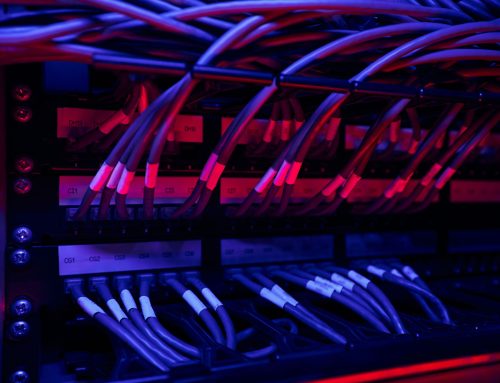Ethernet is a common solution for improving Internet speeds, but what exactly is it? Simply put, Ethernet is a network of cables that link devices within local area networks (LAN) and enable communication by transmitting data. (Watch a short video to learn more about Ethernet and how it works.) There are several types of Ethernet cables that can be used for different purposes and applications. We will take a look at those different types of cables today.
A Brief History of Ethernet Cables
Engineer and entrepreneur Bob Metcalfe designed the first Ethernet cables in 1973. These early versions, 10BASE5 and 10BASE2, used stiff copper cables with half-inch and quarter-inch thick diameters, respectively. The ten in both names stands for ten megabits per second (Mbps), the cables’ data transfer speed. The word base is short for baseband and signifies the type of network that the cables were compatible with. Finally, the five and two represent how many meters long the cable could be before attenuation set in.
Attenuation is the loss of signal strength in networking cables or connections.
Ethernet cables have come a long way since 1973. Now, there are several types of Ethernet cables that can be used to meet different needs in different applications. We’ll explore some of the most common types in today’s blog post.
Outdated Ethernet Cables: CAT3, CAT4, & CAT5
Before we dive into the most common types of Ethernet cables used today, let’s take a look at the past and see how far they have come since 10BASE5 and 10BASE2. CAT3 was the first official standards-based cable, introduced in 1991. It was later replaced by CAT4 and CAT5, neither of which are used today. Believe it or not, you might still come across a few CAT3 cables in older voice installations for commercial buildings.
The CAT in each type of Ethernet cable stands for category.
CAT5e
In 2001, CAT5e was introduced to improve CAT5 cables; the e stands for enhanced. These cables featured better crosstalk for higher speeds. Used in phone lines, home networks, and office networks for basic Internet access, they have a frequency of 100 MHz and a speed of 1 Gbps. The maximum length of CAT5 cables is 324 feet.
CAT6
CAT6 Ethernet cables are similar to CAT5e cables in that they are used for phone lines, home networks, and office networks. They differ in their improved performance, with a frequency of 250 MHz and a speed of 1 Gbps. There is an enhanced version of CAT6, CAT6e, that offers better crosstalk. The maximum length of CAT6 cables is 700 feet, more than double the length of CAT5 cables.
CAT6a
The a in this cable name stands for augmented, meaning that it performs at higher standards than other CAT6 cables.Rather than being used in homes, these cables are ideal for office networks and data centers. They have a frequency of 500 MHz and a speed of 10 Gbps, and they are the recommended cable for horizontal LAN deployments.
CAT7
Used primarily in data centers, CAT7 cables have a frequency of 600 MHz and a speed of 10 Gbps. This cable is not recognized as an official IEEE cabling standard; because of this, it is not commonly used.
CAT8
CAT8 cabling offers faster throughput over short distances.It has a frequency of 2,000 MHz and a speed of 40 Gbps. These cables are used to connect network equipment in data centers. The maximum lengh when supporting data speeds of 10 Gbps and lower is 328 feet.
Benefits of Ethernet Cables
Ethernet cables offer many advantages to individuals and businesses, but we will touch on just a few here.
- Speed
The primary benefit they offer is speed. Compared to wireless connections, Ethernet can achieve much higher speeds. Additionally, it provides more consistent speeds than WiFi, which runs into signal interference issues. - Security
Ethernet connections are more secure than wireless connections because they have control over who can access the network. This makes Ethernet connections safer from hackers. - Affordability
Ethernet cabling is less expensive to install than wireless networks.
In addition to these benefits, Ethernet cables are efficient and reliable, making them a great choice for small and large businesses alike.
Disadvantages of Ethernet Cables
Despite its many advantages, there are some disadvantages to Ethernet cables.
- Because it is designed for shorter distances, an Ethernet network can be time-consuming and expensive to expand.
- Unlike WiFi networks, Ethernet networks should be installed by a professional.
- Ethernet networks limit the number of connections that can be used.
Find a Professional to Install Ethernet Cables
With so many types of Ethernet cables to choose from, it is important to work with a cabling expert who is familiar with each type and can recommend the best one for your application and needs. If you have a business in Winchester, Virginia or the surrounding area, the team at Suite Office Systems would love to work with you.
Whether you need two or 20,000 cables, we have the expertise to help. We install all Category 5E to Category 8 and OM3/OM4 fiber optic networks for tenant improvement, design build, high rise/multi-story, and campus environments. We also install a wide variety of audio video, security and control cables, as well as fiber optic cabling systems. Contact us today to request a quote.






